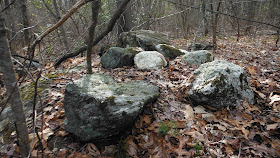The Park was bulldozed into civilization as we now know it during the 1970's. The spot was once farmland of course - and someone will prove it to you by showing you the old stone walls, recalling a myth that this was "wilderness" until around 1700. Some old stories survive about Indian incursions and an incident or two in the general area, still sometimes popping up in the news media: http://www.nhregister.com/article/NH/20120926/NEWS/309269896
I've walked by this spot a bunch of times, as have many people, at the edge of the modern landscaping, a boulder with some stones piled on it by the walking path:
Closer, it seems there are two distinct circles:
One has a distinct Manitou Stone inside the circle of cobbles:
Looking back to the more white quartzy construction, I pondered if this white quartz cobble might perhaps be a similar such Manitou Stone rolled over onto its side, knocked out of place:
I was a little surprised to see that the west side of the boulder had been "walled," for lack of a better term, stones stacked up against the side of it:
“Once one awakens to their presence they (Ceremonial Stone
Landscape Features) seem to be everywhere,” writes Diane Dix. https://nolumbekaproject.org/sacred-site-preservation/
"Finally, I’d say that while many stone features
have been destroyed, there are still thousands left. They are hiding in our
back yards, in our state forests, along our waterways—everywhere in plain
sight. Help others realize why they should be respectful of these when they
find them, help them imagine what it might mean to have a religiously-important
structure (e.g. something built to honor someone in your family) technically
belong to someone else, or be at risk from vandals, pot-hunters, and
developers. These stone structures are examples of how humans found a way to
interact respectfully and in a mutually-beneficial way with nature. They are
Natural Cultural nodes, blueprints for how we will need to think in the future
if we are to survive and allow our natural world survive. They are important
beyond the specific, and they should give us hope." Lisa
McLoughlin; Nolumbeka. {http://www.nofrackedgasinmass.org/2017/02/19/preserving-native-sites/}



















“Once one awakens to their presence they (Ceremonial Stone Landscape Features) seem to be everywhere,” writes Diane Dix."
ReplyDeleteThat is because they ARE everywhere, at least in New England. :~)
dc